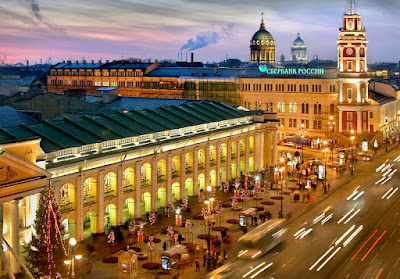The 27th of May marked the 319th anniversary of the founding of St Petersburg by Tsar Peter the Great in 1703. On the site of a captured Swedish fortress and named after apostle Saint Peter.
Saint Petersburg is the heart of Russian culture. It is the city associated with the birth and rise of the Russian Empire closer than any other. Petersburg was the capital city, governed by the Tsars and the Empire, all the way to 1918 when it was replaced by the Bolsheviks who took their government to Moscow. It is the second largest city, on the Neva River and went through name changes too; known as Petrograd from 1914 to 1924 and Leningrad from 1924 to 1991. After a referendum, the original name was restored.
This magnificent city holds in its honour the lions of literature. Petersburg was the pivot for the best of education, art, science and society. It holds immense importance in both poetry and prose. All of Fyodor Dostoevsky's main works are set in Petersburg where he spent the larger of his life. My first exposure to this was in Crime and Punishment where Raskolnikov shows us through "the most intentional and abstract city" as he called it. Though he shows it as a gloomy place, you cannot ignore the fact that it has such a charm, such a deep charm in all its descriptions that the reader develops a homely love for it. Even in Devils, Petersburg is mentioned everywhere. Leo Tolstoy, Nikolai Gogol, Alexander Pushkin and every name you can think of. They all take you to Petersburg and compel you to share their love for it.
Petersburg comprises some of the most beautiful architecture in the world. The Constitutional Court of Russia, the Heraldic Council of the President of the Russian Federation, the National Library of Russia, and the Hermitage (one of the largest art museums in the world) are all in St Petersburg. The Historic Centre of Saint Petersburg and Related Groups of Monuments are a UNESCO World Heritage Site.
The importance of Petersburg in world history, literature, culture and art is of immense magnitude. It is a place where you can find everything and everything of quality. It is one of my greatest desires to visit Petersburg one day. I love St Petersburg as a place of personal sanctity.
I share this extract from The Bronze Horseman by Alexander Sergeyevich Pushkin. I am sure reading it will familiarise you with the affection of Petersburg, even if you knew nothing of it prior.
By the new capital, the younger,
Old Moscow’s eclipsed at once-
Such is eclipsed a queen-dowager
By a new queen when her time comes.
I love you, Peter’s great creation,
I love your view of stern and grace,
The Neva wave’s regal procession,
The grayish granite – her bank’s dress,
The airy iron-casting fences,
The gentle transparent twilight,
The moonless gleam of your nights restless,
When I so easy read and write
Without a lamp in my room lone,
And seen is each huge buildings’ stone
Of the left streets, and is so bright
The Admiralty spire’s flight,
And when, not letting the night’s darkness
To reach the golden heaven’s height,
The dawn after the sunset hastens –
And a half-hour’s for the night.
I love your so sever winter’s
Quite still and fresh air and strong frost,
The sleighs race on the shores river’s,
The girls – each brighter than a rose,
The gleam and hum of the balls’ dances,
And, on the bachelors’ free feast,
The hissing of the foaming glasses
And the punch’s bluish flaming mist.
I love the warlike animation
Of the play-fields of the god Mars,
And horse-and-footmen priests’ of wars
So homogeneous attraction,
In their ranks, in the rhythmic moves,
Those flags, victories and ended,
The glitter of those helmets, splendid,
Shot through in military strives.
I love, O capital my fairest,
Your stronghold guns’ thunder and smoke,
In moments when the northern empress
Adds brunches to the regal oak
Or Russia lauds a winning stroke
To any new and daring foe,
Or, breaking up the light-blue ice,
The Neva streams it and exults,
Scenting the end of cold and snow.
City of Peter, just you shine
And stand unshakable as Russia!
May make a peace with beauty, thine,
The conquered nature’s casual rushes;
And let the Finnish waves forget
Their ancient bondages and malice
And not disturb with their hate senseless
The endless sleep of Peter, great!




Its a wonderful piece of writing!
ReplyDeleteI can feel the beauty and grace of Petersburg.